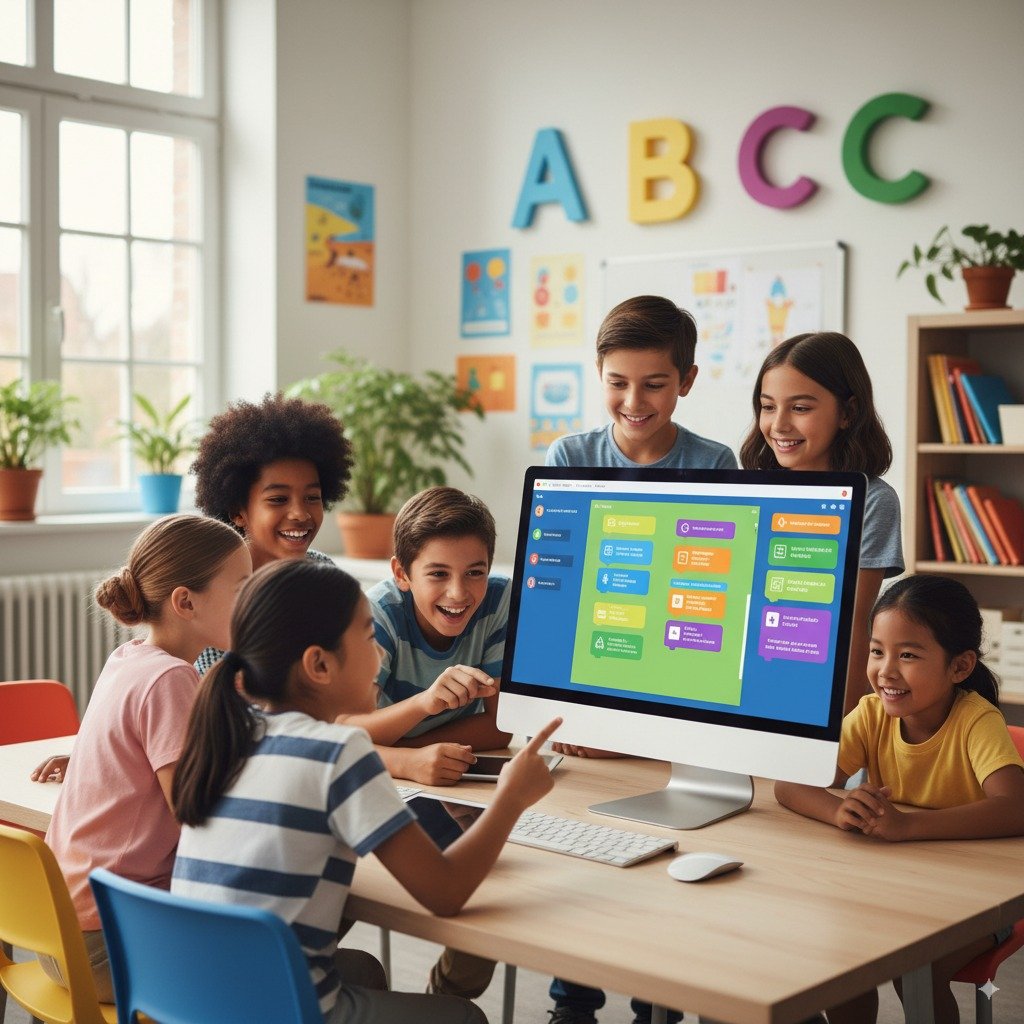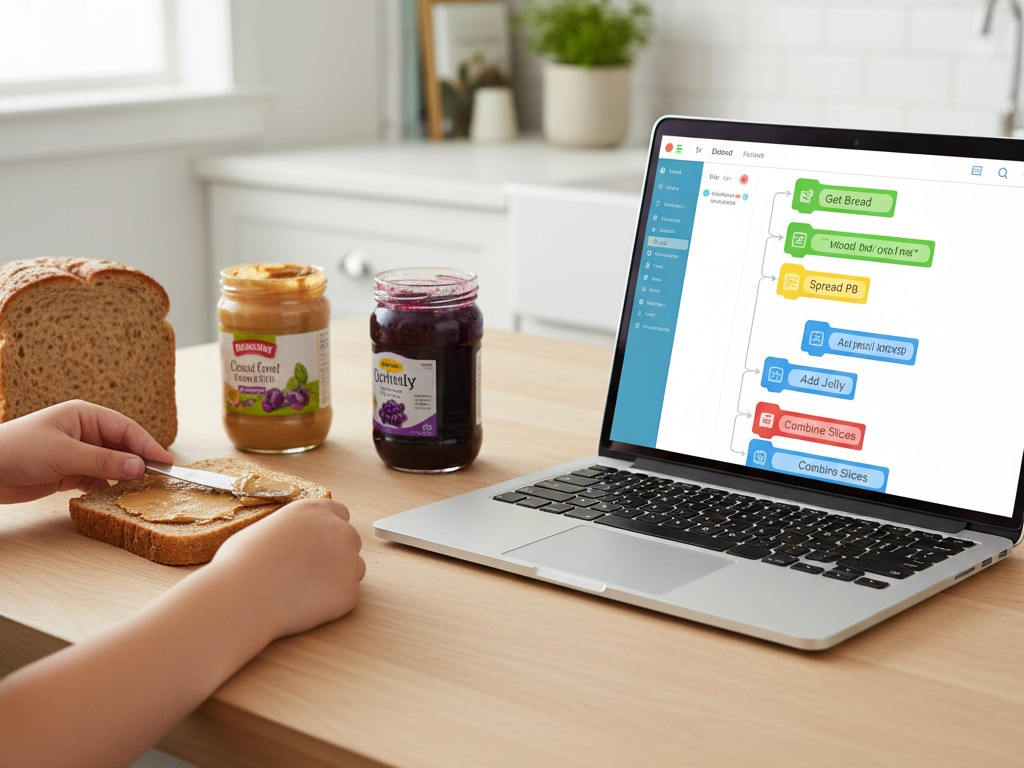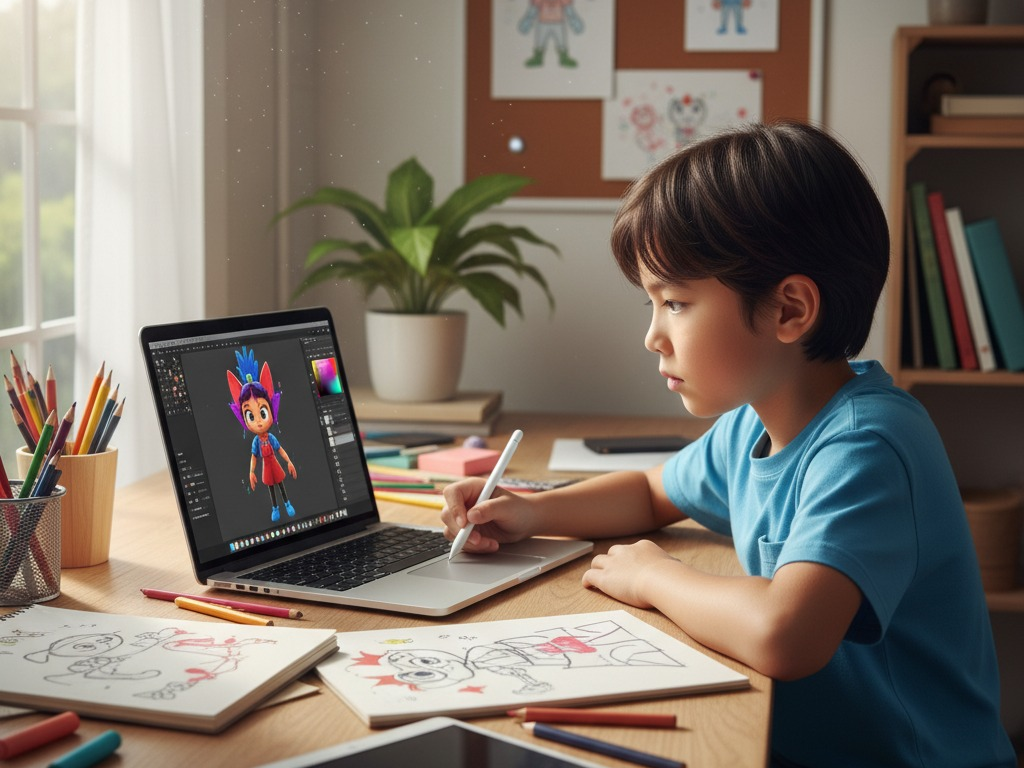
Reading Time: 11 mins

Does your child spend hours on devices but you wish they were learning something valuable instead of just consuming content? Are you worried that your child might fall behind in an increasingly digital world where coding skills are becoming as fundamental as reading and writing? You’re not alone – thousands of parents share these concerns every day.
The consequences of not introducing coding early can be significant. As technology advances rapidly, children who don’t develop computational thinking skills may struggle to keep up academically and professionally. By 2030, experts predict that 85% of jobs will require some form of digital literacy, making coding knowledge more crucial than ever.
That’s where understanding the ABC’s of coding becomes your solution. This comprehensive guide will transform complex programming concepts into digestible, fun lessons that both you and your child can understand and enjoy. By the end of this article, you’ll have a clear roadmap to introduce your child to the wonderful world of coding, setting them up for success in our digital future.
Coding, also known as programming, is simply the process of giving instructions to computers using a special language they can understand. Think of it like teaching your pet a new trick – you break down what you want them to do into simple, clear steps they can follow.
When we talk about the ABC’s of coding, we’re referring to the fundamental concepts that form the building blocks of all programming. Just as children learn the alphabet before reading complex books, young programmers need to master these basic principles before creating amazing digital projects.
The beauty of coding lies in its logical structure and creative possibilities. It combines mathematical thinking with artistic expression, problem-solving with storytelling. This unique blend makes coding an ideal skill for developing both analytical and creative thinking in children.
At ItsMyBot, we’ve seen thousands of kids discover their passion for technology through our personalized coding programs. The excitement in a child’s eyes when their first program runs successfully is truly magical – it’s the moment they realize they can create, not just consume, technology.

An algorithm is essentially a recipe for solving problems. Just like following steps to bake cookies or build a LEGO castle, algorithms provide step-by-step instructions that computers can follow to complete tasks.
Let’s break this down with a simple example. If you want to make a peanut butter and jelly sandwich, your algorithm might look like:
This same logical thinking applies to coding. When children learn to think algorithmically, they develop crucial problem-solving skills that extend far beyond programming.
Key Algorithm Concepts for Kids:
These concepts form the foundation of computational thinking, a skill that’s valuable in every subject from math to science to creative arts. Scratch coding for kids is an excellent way to introduce these algorithmic concepts through visual programming.
Block-based programming revolutionizes how children learn to code by replacing confusing text with colorful, puzzle-like pieces. Instead of typing complex commands, kids drag and drop visual blocks that represent different programming concepts.
What is block coding for kids explains how this visual approach eliminates syntax errors that often frustrate beginning programmers. When blocks only fit together in logical ways, children can focus on creative problem-solving rather than memorizing punctuation rules.
Popular block-based programming platforms include:
Scratch: The most popular platform worldwide, developed by MIT specifically for children. Scratch allows kids to create interactive stories, games, and animations by snapping together colorful code blocks.
Blockly: Google’s visual programming editor that powers many educational coding platforms. It provides a smooth transition from visual blocks to text-based programming.
Code.org: Offers hour-of-code activities and comprehensive computer science curricula using block-based programming for various age groups.
The genius of block programming lies in its intuitive nature. Children naturally understand that puzzle pieces should fit together logically. This visual approach builds confidence and eliminates the fear of making mistakes that often accompanies traditional text-based programming.
Through our experience at ItsMyBot, we’ve observed that children who start with block programming develop stronger foundational programming concepts and transition more easily to text-based languages later.

Creativity is where coding truly shines for children. Unlike traditional subjects with predetermined answers, programming encourages infinite possibilities and personal expression. The “C” in our ABC’s of coding represents this magical moment when technical skills meet imagination.
Coding creativity manifests in countless ways:
The creative aspect of coding is particularly important for maintaining long-term interest. While learning syntax and concepts provides the foundation, creativity provides the motivation to continue learning and exploring.
Consider how children approach making a clicker game on Scratch. They start with basic mechanics but quickly begin adding personal touches – unique characters, custom sound effects, special power-ups, or themed storylines that reflect their individual interests and personalities.
This creative freedom helps children develop crucial 21st-century skills including:
Mastering the ABC’s of coding requires understanding several fundamental concepts that appear in every programming language. These building blocks form the vocabulary of computational thinking.
Variables: Think of variables as labeled containers that store information. Just like putting toys in labeled boxes, variables help organize and remember data in programs. A variable might store a player’s score, a character’s name, or the current level in a game.
Conditionals: These are the decision-making tools of programming. “If it’s raining, then take an umbrella” is a conditional statement. In coding, conditionals help programs respond differently to various situations, making software interactive and responsive.
Loops: When you need to repeat actions, loops save time and effort. Instead of writing the same instruction ten times, a loop can execute it automatically. This concept is crucial for creating animations, processing data, and building efficient programs.
Functions: Functions are reusable chunks of code that perform specific tasks. Like a calculator’s “add” function, programming functions can be called whenever needed, making code organized and maintainable.
Events: In interactive programs, events trigger responses. Clicking a button, pressing a key, or moving the mouse are all events that can make programs respond to user actions.
Understanding these concepts provides the foundation for learning any programming language. Whether children eventually learn Python, JavaScript, or C++, these fundamental ideas remain consistent across all platforms.
Choosing the right programming language depends on a child’s age, interests, and learning goals. Here’s a comprehensive breakdown of the most effective options:
Ages 5-8: Visual Block Programming
Ages 8-12: Advanced Block Programming
Ages 12-16: Transition to Text-Based Languages
The best 7 coding languages for game developers provides deeper insight into specialized programming paths that align with children’s gaming interests.
Our approach at ItsMyBot emphasizes gradual progression, ensuring children master concepts at each level before advancing. This methodology prevents frustration and builds lasting confidence in programming abilities.
The digital landscape offers numerous excellent platforms for young coders, each with unique strengths and approaches. Selecting the right tools can significantly impact a child’s learning experience and long-term engagement with programming.
Free Online Platforms:
Code.org: Comprehensive curriculum with guided lessons, puzzles, and projects. Their Hour of Code activities provide perfect introductions to programming concepts.
Scratch: MIT’s flagship platform offers unlimited creative possibilities. The large community provides inspiration and collaboration opportunities.
Khan Academy: Structured courses in computer programming, including JavaScript, HTML/CSS, and SQL databases.
Paid Premium Platforms:
Tynker: Gamified learning environment with structured pathways from visual blocks to advanced programming languages.
CodeCombat: RPG-style game that teaches actual programming syntax through engaging gameplay mechanics.
WhiteHat Jr.: Live, personalized coding classes with certified instructors (though alternatives may provide better value).
Physical Coding Tools:
LEGO Mindstorms: Combines building with programming, perfect for kinesthetic learners who need hands-on experience.
Sphero Robots: Programmable robots that make coding concepts visible through physical movement and interaction.
Arduino Kits: For older children interested in electronics and engineering applications of programming.
The key is matching tools to learning styles and interests. Visual learners thrive with block-based platforms, while kinesthetic learners benefit from robotics integration. Top 7 coding apps for kids ages 8-16 provides detailed comparisons of mobile learning options.
The advantages of introducing children to programming extend far beyond future career preparation. Coding education develops essential cognitive skills that benefit every aspect of learning and development.
Cognitive Development Benefits:
Enhanced Problem-Solving: Programming breaks complex challenges into manageable steps, teaching systematic thinking approaches applicable to mathematics, science, and everyday situations.
Improved Mathematical Understanding: Coding reinforces mathematical concepts through practical application, making abstract ideas concrete and understandable.
Logical Reasoning: Conditional statements, loops, and algorithms develop structured thinking patterns that improve performance across academic subjects.
Creative Expression: Unlike traditional subjects with predetermined answers, programming encourages innovation and personal creativity through unlimited possibilities.
Academic Performance Improvements:
Research consistently demonstrates that students with coding experience perform better in mathematics, science, and reading comprehension. The logical thinking patterns developed through programming enhance analytical skills across all subjects.
Social and Emotional Benefits:
Confidence Building: Successfully creating working programs builds self-efficacy and confidence in technical abilities.
Persistence and Resilience: Debugging teaches children that mistakes are learning opportunities, not failures.
Communication Skills: Explaining code logic improves verbal and written communication abilities.
Benefits of coding for elementary kids explores these advantages in greater detail, providing scientific research supporting early programming education.
Despite growing awareness of programming’s importance, several persistent myths prevent parents from introducing their children to coding. Let’s address these misconceptions with facts and experience from our work at ItsMyBot.
Myth 1: “Coding is too difficult for young children” Reality: Age-appropriate tools make programming accessible to preschoolers. Visual block programming eliminates syntax complexity, allowing children to focus on logical thinking rather than memorizing commands.
Myth 2: “You need to be good at math to code” Reality: While advanced programming uses mathematical concepts, basic coding requires logical thinking more than advanced mathematics. Many successful programmers developed mathematical skills through coding rather than vice versa.
Myth 3: “Coding is only for future programmers” Reality: Programming develops transferable skills including problem-solving, logical reasoning, and creative thinking that benefit all career paths.
Myth 4: “Screen time for coding is harmful” Reality: Productive screen time differs significantly from passive consumption. Coding represents active, educational engagement that develops cognitive abilities.
Myth 5: “Coding stifles creativity” Reality: Programming is fundamentally creative, combining technical skills with artistic expression. Children create games, stories, art, and music through coding.
Myths about coding for kids provides comprehensive myth-busting with supporting research and real-world examples from successful young programmers.
Understanding these facts helps parents make informed decisions about their children’s technology education, moving beyond unfounded concerns to embrace the tremendous opportunities programming provides.
Beginning your child’s programming adventure doesn’t require technical expertise or expensive equipment. With the right approach and resources, any family can successfully introduce coding concepts at home.
Step 1: Assess Interest and Readiness Start by observing your child’s natural interests. Do they enjoy puzzles, building with blocks, or creating stories? These activities indicate readiness for programming concepts.
Step 2: Choose Age-Appropriate Tools Begin with visual programming platforms that match your child’s developmental stage. Scratch Jr. works perfectly for younger children, while traditional Scratch suits elementary-age learners.
Step 3: Start with Simple Projects How to start learning to code roadmap for beginners recommends beginning with basic animations or simple games before attempting complex projects.
Step 4: Encourage Experimentation Allow children to explore and make mistakes. The debugging process teaches valuable problem-solving skills and builds resilience.
Step 5: Connect with Community Join online forums, local coding clubs, or summer camps where children can share projects and learn from peers.
Step 6: Consider Professional Instruction While many resources support independent learning, structured programs provide systematic skill development and personalized feedback. How to teach kids coding online benefits of early education explains the advantages of professional instruction.
Creating a Supportive Learning Environment:
Designate Learning Space: Create a dedicated area for coding activities with minimal distractions and necessary materials.
Celebrate Progress: Acknowledge achievements and effort rather than just completed projects.
Learn Together: Parent participation increases engagement and provides bonding opportunities.
Set Realistic Expectations: Progress varies among children; focus on individual improvement rather than comparing to others.
The ABC’s of coding – Algorithms, Blocks, and Creativity – provide a solid foundation for understanding programming fundamentals. By mastering these concepts, children develop not just technical skills but critical thinking abilities that benefit every aspect of their education and future careers.
Remember that learning to code is a journey, not a destination. Every child progresses at their own pace, and the key is maintaining enthusiasm and curiosity throughout the process. Whether your child becomes a professional programmer or simply gains valuable problem-solving skills, the benefits of coding education are undeniable.
The digital future belongs to those who understand technology’s inner workings, not just its surface features. By introducing your child to programming now, you’re providing them with tools to become creators and innovators in an increasingly technological world.
Ready to start your child’s coding adventure? Is coding really helpful for kids provides additional insights and motivation for beginning this exciting journey.
Take Action Today: Download our free “Getting Started with Coding” checklist and give your child the gift of digital literacy that will last a lifetime. The future is coding – and it starts with understanding the ABC’s.
